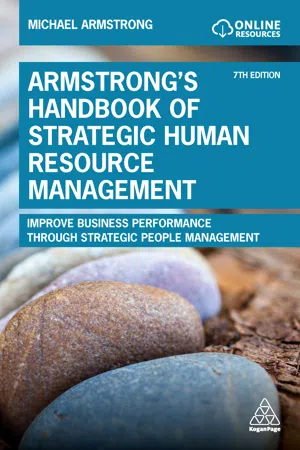
Armstrong's Handbook of Strategic Human Resource Management
Improve Business Performance Through Strategic People Management
- English
- ePUB (mobile friendly)
- Available on iOS & Android
Armstrong's Handbook of Strategic Human Resource Management
Improve Business Performance Through Strategic People Management
About this book
Armstrong's Handbook of Strategic Human Resource Management is a complete guide to integrating HR strategies with wider organizational goals and objectives approaches to achieve sustained competitive advantage. Supported by key learning summaries, source reviews and practical real-life examples from organizations including UNICEF and General Motors (GM), this book provides coverage of HRM strategies in key areas of the function such as employee engagement, talent management and learning and development, as well as strategic HRM approaches in an international context. This fully revised seventh edition of Armstrong's Handbook of Strategic Human Resource Management contains new chapters on evidence-based strategic HRM, employee wellbeing strategies and HR analytics, as well as additional case studies and updated wider content to reflect the latest research and thinking. It remains an indispensable resource for both professionals and those studying HR qualifications, including undergraduate and masters degrees and the CIPD's advanced level qualifications. Online supporting resources include lecture slides and comprehensive handbooks for lecturers and students which include self-assessment questions, case study exercises, and a glossary and literature review.
Frequently asked questions
- Essential is ideal for learners and professionals who enjoy exploring a wide range of subjects. Access the Essential Library with 800,000+ trusted titles and best-sellers across business, personal growth, and the humanities. Includes unlimited reading time and Standard Read Aloud voice.
- Complete: Perfect for advanced learners and researchers needing full, unrestricted access. Unlock 1.4M+ books across hundreds of subjects, including academic and specialized titles. The Complete Plan also includes advanced features like Premium Read Aloud and Research Assistant.
Please note we cannot support devices running on iOS 13 and Android 7 or earlier. Learn more about using the app.
Information
Strategic human resource management (SHRM)
Human resource management
Introduction
The nature of HRM
HRM philosophy
That human resource policies should be integrated with strategic business planning and used to reinforce an appropriate (or change an inappropriate) organizational culture, that human resources are valuable and a source of competitive advantage, that they may be tapped most effectively by mutually consistent policies that promote commitment and which, as a consequence, foster a willingness in employees to act flexibly in the interests of the ‘adaptive organization’s’ pursuit of excellence.
Underpinning theories of HRM
Models of HRM
The Harvard model of HRM
Table of contents
- Introduction
- Part One Strategic human resource management (SHRM)
- 01 Human resource management
- 02 Strategic management
- 03 The concept of strategic human resource management
- 04 The evolution of SHRM
- 05 The reality of SHRM
- Part Two People strategy in general
- 06 The concept of people management
- 07 The nature and practice of people strategy
- 08 Developing people strategy
- 09 Implementing people strategy
- 10 The strategic role of people professionals
- Part Three Specific people strategies
- 11 Organization development strategy
- 12 Human capital management strategy
- 13 Knowledge management strategy
- 14 Corporate social responsibility strategy
- 15 Organizational performance strategy
- 16 Individual performance strategy
- 17 Digital strategy for people management
- 18 Employee engagement strategy
- 19 Resourcing strategy
- 20 Talent management strategy
- 21 Diversity and inclusion strategy
- 22 Learning and development strategy
- 23 Reward strategy
- 24 Employment relationships strategy
- 25 Employee wellbeing strategy
- 26 International people management strategy
- Author Index
- Subject Index